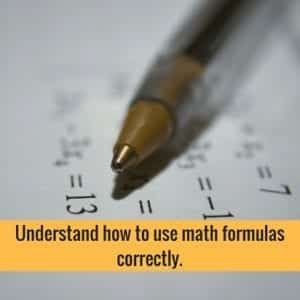The ACT Math test is a 60-minute test with 60 questions that cover all mathematical topics taught up until grade 12. You can give yourself about one minute to answer each test question. This is a multiple choice test, which means you don’t have to show your solution to the math problems.
Check out our ACT Math Practice Test here.
You also don’t have to memorize formulas for the test, but you need to understand math problems and basic formulas and be able to perform the basic computation.
Related Topic: How ACT Reviewers And Guides Help You Boost Your ACT Score
The test focuses on topics that are needed for the student’s success in college math. Your math test score will reflect your total score for the 60 questions plus your category scores for specific math skills.
Scoring high on the ACT math test will help you improve your overall score and will also increase your chances of getting accepted into math-based college courses such as Engineering, Statistics, or Accountancy. This is because it tells your future school that you have the skills and knowledge needed to succeed on a math-based course.
Calculators
You are allowed to use a calculator during the test. A 4-function, scientific, or graphics calculator may be used as long as they’re not included on the list of prohibited calculators. Test-takers are advised to confirm whether the calculator is approved and if they need backup calculators before the test. It is best to bring an extra calculator or a set of batteries as a backup.
Related Topic: ACT Test Introduction, Registration, Dates & Score
ACT Math Test Content
The ACT Math test covers three categories: Preparing for Higher Math (57-60%), Integrating Essential Skills (40-43%), and Modeling (>25%).
Preparing for Higher Math includes these subcategories:
Number & Quantity (7-10%):
Numerical Reasoning
Integer and Rational Exponents
Vectors and Matrices
Algebra (12-15%)
Algebraic Expressions
Solving Difference Kinds of Equations
Related Topic: ACT Scores
Functions (12-15%)
Function
Notation
Representation
Application
Geometry (12-15%)
Shapes and Solids
Composition of Objects
Statistics and Probability (8-12%)
Describing Center and Spread of Distributions
Application and Analysis of Data Collection Methods
Calculating Probabilities
Understanding and Modeling of Relationships in Bivariate Data
Related Topic: ACT Test Dates
5 Tips To Score High On The ACT Math Test

1. Start with the right mindset.

Stop saying that you’re poor at math or that math is not your cup of tea. Your ACT math score depends on how well you’ve prepared for math and your study strategies. It is not an IQ test. Like most subjects, the ACT Math test is the type of test that gets easier with practice.
Related Topic: ACT Registration
2. Answer the easy questions first.

The questions on the Math ACT test are arranged from easy to difficult. Focus on getting the first questions right and save the hard ones for last, usually the last 10 to 12 questions of the test. Be aware of the time limit. You only have roughly one minute per test question.
3. Know your weakness and take practice tests.

Math is a subject that gets better with practice. Taking practice tests will help you determine your weakness and it also tells you where to focus your energy when studying for the test. Math drills through ACT practice tests will help you get better at the subject.
4. Understand how to use math formulas correctly.

It’s not enough to memorize formulas. You need to know how to use them correctly. Practice using formulas for geometry (area, perimeter, volume, Pythagorean theorem), trigonometry (sine, cosine, tangent, cosecant, secant, cotangent), algebra (slope, slope-intercept form, logarithms), and probability and statistics (average, probabilities, combinations, percentages).
Related Topic: ACT Practice Test
5. Read and understand the question.

Go through the question carefully and understand what is being asked. Solve the problem and look for your solution in the answer options. Use the calculator to do basic operations and double check your work.
Related Topics:
- Ace The ACT Writing Test Scores
- 3 Things You Need To Do On Actual ACT Test Date
- 8 Useful Tips To Improve Your ACT Science Score
- How To Apply For The ACT Test
- ACT Test: Should You Aim For A High Score?
- Why You Need Help In Preparing For Your ACT Test
- ACT Test Day Requirements To Bring With You On The Exam Day
- ACT Math Practice Tests 3
- ACT Registration And Requirements
